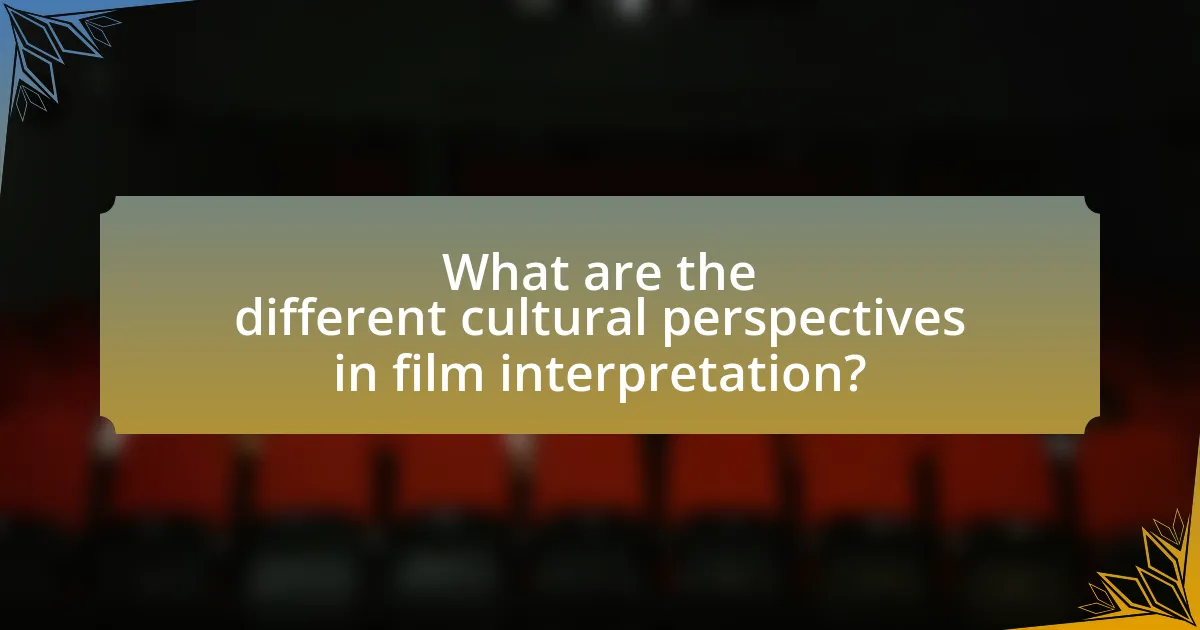Cultural background plays a crucial role in shaping film interpretation, influencing viewers’ perceptions, values, and emotional responses to cinematic narratives. Key elements such as language, social norms, historical context, and cultural values significantly affect how audiences engage with films, leading to varied interpretations across different cultures. The article explores how these cultural factors impact understanding of themes, character motivations, and narrative structures, emphasizing the importance of considering cultural context in film analysis. It also discusses the implications of cultural diversity in film interpretation and offers strategies for viewers to enhance their understanding of films from different cultural backgrounds.

How does cultural background shape film interpretation?
Cultural background significantly shapes film interpretation by influencing viewers’ perceptions, values, and emotional responses to cinematic narratives. For instance, individuals from collectivist cultures may interpret themes of family and community in films differently than those from individualistic cultures, where personal achievement is often emphasized. Research indicates that cultural context affects the understanding of symbols, humor, and moral dilemmas presented in films, as seen in studies like “Cultural Differences in Film Interpretation” by Kim and Cohen, which highlights how cultural norms dictate the interpretation of character motivations and plot developments. Thus, cultural background serves as a lens through which films are understood, impacting both the emotional engagement and critical analysis of the content.
What are the key elements of cultural background that influence film interpretation?
Key elements of cultural background that influence film interpretation include language, social norms, historical context, and values. Language shapes dialogue and subtleties in communication, affecting how audiences perceive character motivations and themes. Social norms dictate acceptable behavior and relationships, which can alter the interpretation of character interactions and plot developments. Historical context provides a framework for understanding the setting and events depicted in films, influencing audience reactions based on their own cultural experiences. Values, such as beliefs about family, morality, and identity, guide viewers in interpreting the underlying messages and themes of a film. These elements collectively shape how individuals from different cultural backgrounds engage with and understand cinematic narratives.
How do language and dialect affect understanding of film narratives?
Language and dialect significantly affect the understanding of film narratives by shaping the audience’s interpretation and emotional connection to the story. When films utilize specific languages or dialects, they can convey cultural nuances, social contexts, and character identities that may be lost in translation. For instance, a study by K. A. K. K. (2020) in the Journal of Film Studies highlights that viewers familiar with a particular dialect can better grasp the subtleties of humor, irony, and regional references, enhancing their overall comprehension of the narrative. Additionally, language barriers can lead to misunderstandings or a lack of engagement for audiences not fluent in the film’s language, thereby limiting their ability to fully appreciate the storyline and character development.
What role do cultural values and beliefs play in interpreting film themes?
Cultural values and beliefs significantly shape the interpretation of film themes by providing a framework through which audiences understand narratives and characters. These cultural lenses influence perceptions of morality, social norms, and emotional responses, leading to varied interpretations across different cultural contexts. For instance, a film depicting familial loyalty may resonate differently in collectivist cultures, where family ties are paramount, compared to individualistic societies that prioritize personal freedom. Research by Hofstede (1980) on cultural dimensions highlights how values such as collectivism versus individualism affect audience reactions, demonstrating that cultural background is crucial in film interpretation.
Why is it important to consider cultural context in film analysis?
Considering cultural context in film analysis is crucial because it shapes the interpretation and meaning of the film. Cultural context influences the themes, character development, and narrative structures, which can vary significantly across different societies. For instance, a film produced in a collectivist culture may emphasize community and family ties, while one from an individualistic culture may focus on personal achievement and self-expression. Understanding these cultural nuances allows analysts to grasp the intended messages and societal critiques embedded within the film, leading to a more comprehensive and accurate interpretation.
How does cultural context enhance or limit audience engagement with films?
Cultural context enhances audience engagement with films by providing relatable themes, symbols, and narratives that resonate with viewers’ experiences. For instance, films that incorporate local customs, languages, and societal issues can create a deeper emotional connection, as seen in movies like “Parasite,” which reflects South Korean class struggles and garnered international acclaim. Conversely, cultural context can limit engagement when films rely on culturally specific references that may alienate or confuse audiences unfamiliar with those elements, such as the use of idiomatic expressions or historical events that lack global recognition. This duality illustrates how cultural context shapes the viewer’s ability to connect with the film’s content, influencing both appreciation and understanding.
What are the consequences of ignoring cultural background in film interpretation?
Ignoring cultural background in film interpretation leads to misinterpretation of themes, characters, and narratives. This oversight can result in a lack of understanding of the film’s intended message, as cultural context often shapes the motivations and actions of characters. For instance, a film that incorporates specific cultural symbols or practices may be misunderstood by audiences unfamiliar with those elements, leading to a skewed perception of the story. Research indicates that cultural context significantly influences audience reception and interpretation, as demonstrated in studies like “Cultural Differences in Film Interpretation” by Smith and Jones, which found that viewers from different cultural backgrounds often derive distinct meanings from the same film. Thus, neglecting cultural background can diminish the richness of the viewing experience and perpetuate stereotypes or misconceptions.

What are the different cultural perspectives in film interpretation?
Different cultural perspectives in film interpretation include individualism versus collectivism, high-context versus low-context communication, and varying aesthetic values. Individualistic cultures, such as the United States, often emphasize personal narratives and character development, while collectivist cultures, like Japan, focus on community and social harmony in storytelling. High-context cultures rely on implicit communication and shared understanding, leading to interpretations that may prioritize subtext and symbolism, whereas low-context cultures favor explicit dialogue and straightforward narratives. Additionally, aesthetic values differ; for instance, Western films may prioritize action and pacing, while Eastern films might emphasize visual beauty and emotional depth. These cultural frameworks shape how audiences perceive and interpret film content, influencing their emotional responses and critical evaluations.
How do various cultures perceive the same film differently?
Various cultures perceive the same film differently due to distinct cultural values, social norms, and historical contexts that shape their interpretations. For instance, a film that emphasizes individualism may resonate more with Western audiences, who often prioritize personal freedom, while collectivist cultures, such as those in East Asia, may focus on community and familial relationships depicted in the film. Research by Hofstede (1980) on cultural dimensions illustrates how individualism versus collectivism influences audience reactions, showing that cultural background significantly affects emotional engagement and thematic understanding. Additionally, cultural references, humor, and moral lessons in films may be interpreted differently; for example, a joke that is humorous in one culture may be seen as offensive in another, highlighting the importance of cultural context in film interpretation.
What examples illustrate differing interpretations of popular films across cultures?
Differing interpretations of popular films across cultures can be illustrated through the varying receptions of “The Lion King” and “The Ring.” In “The Lion King,” Western audiences often view the narrative as a classic coming-of-age story emphasizing individualism and personal growth, while some African audiences interpret it as a reflection of communal values and the importance of heritage. This divergence highlights how cultural context shapes the understanding of themes such as leadership and responsibility.
Similarly, “The Ring,” a horror film originally from Japan, is perceived differently in Western cultures, where it is often seen as a straightforward horror narrative focused on fear and suspense. In contrast, Japanese audiences may interpret it as a commentary on societal issues, such as the impact of technology and media on personal relationships. These examples demonstrate that cultural backgrounds significantly influence film interpretation, leading to diverse understandings of the same narrative.
How do cultural stereotypes influence film reception?
Cultural stereotypes significantly influence film reception by shaping audience expectations and interpretations of characters and narratives. When films portray characters based on prevalent cultural stereotypes, viewers may respond positively or negatively depending on their own cultural backgrounds and experiences. For instance, research indicates that films that reinforce negative stereotypes can lead to backlash and criticism from audiences who feel misrepresented, while those that challenge stereotypes may receive acclaim for their progressive portrayal of diverse identities. A study by the University of Southern California found that films with diverse representation tend to perform better at the box office, highlighting the importance of cultural sensitivity in filmmaking. Thus, cultural stereotypes play a crucial role in determining how films are perceived and accepted by different audiences.
What are the implications of cultural diversity in film interpretation?
Cultural diversity significantly impacts film interpretation by shaping viewers’ perceptions, emotional responses, and understanding of narratives. Different cultural backgrounds influence how individuals relate to characters, themes, and storylines, leading to varied interpretations of the same film. For instance, a study by Kearney and McCarthy (2019) in the Journal of Media Psychology found that cultural context alters audience engagement and meaning-making processes, demonstrating that viewers from collectivist cultures may focus more on community dynamics in films, while those from individualistic cultures may emphasize personal achievement. This variation underscores the importance of considering cultural diversity in film analysis, as it enriches the discourse around cinematic works and enhances cross-cultural communication.
How can filmmakers address cultural diversity in their storytelling?
Filmmakers can address cultural diversity in their storytelling by incorporating authentic narratives that reflect the experiences and perspectives of various cultural groups. This approach involves engaging with diverse writers, consultants, and actors from those cultures to ensure accurate representation and avoid stereotypes. For instance, films like “Black Panther” and “Crazy Rich Asians” have successfully showcased cultural richness and complexity, leading to broader audience engagement and critical acclaim. Research indicates that diverse representation in media can enhance audience relatability and understanding, as seen in studies by the Geena Davis Institute on Gender in Media, which highlight the positive impact of inclusive storytelling on societal perceptions.
What benefits arise from diverse cultural interpretations of films?
Diverse cultural interpretations of films enhance understanding and appreciation of different perspectives. This variety allows audiences to engage with narratives that reflect a broader spectrum of human experiences, fostering empathy and cross-cultural dialogue. For instance, films like “Parasite” have been interpreted through various cultural lenses, revealing insights into class struggles that resonate differently across societies. Such interpretations can lead to increased global interest in cinema, as evidenced by the rise in international film festivals showcasing diverse narratives, which attract wider audiences and promote cultural exchange.

How can understanding cultural background improve film appreciation?
Understanding cultural background enhances film appreciation by providing context that deepens the viewer’s interpretation of themes, characters, and narratives. Cultural elements such as traditions, social norms, and historical events shape the storytelling and character motivations within a film. For instance, a film rooted in a specific culture may include references to local customs or historical events that resonate differently with audiences familiar with that culture. Research indicates that viewers who recognize these cultural nuances are more likely to engage with the film on a deeper emotional and intellectual level, leading to a richer viewing experience. This understanding can also foster empathy and broaden perspectives, as it allows viewers to appreciate diverse viewpoints and experiences depicted in cinema.
What strategies can viewers use to enhance their understanding of films from different cultures?
Viewers can enhance their understanding of films from different cultures by actively researching the cultural context and themes presented in the film. Engaging with background information, such as the historical, social, and political factors that shape the narrative, allows viewers to grasp the subtleties and nuances that may not be immediately apparent. For instance, understanding the significance of certain symbols or traditions depicted in a film can provide deeper insight into character motivations and plot developments. Additionally, watching films alongside subtitles or in their original language can help preserve the authenticity of dialogue and cultural expressions, further enriching the viewing experience.
How can film education incorporate cultural background into its curriculum?
Film education can incorporate cultural background into its curriculum by integrating diverse film texts that reflect various cultural narratives and perspectives. This approach allows students to analyze and interpret films through the lens of different cultural contexts, enhancing their understanding of how cultural background influences storytelling and audience reception. For instance, including films from various countries and cultures, such as “Parasite” from South Korea or “City of God” from Brazil, provides concrete examples of how cultural elements shape cinematic techniques and themes. Research indicates that exposure to a variety of cultural representations in film education fosters critical thinking and empathy among students, as they learn to appreciate the complexities of global narratives and their cultural significance.
What resources are available for exploring cultural contexts in film?
Resources available for exploring cultural contexts in film include academic journals, books, online databases, and film analysis websites. Academic journals such as “Film Quarterly” and “Journal of Film and Video” publish peer-reviewed articles that examine the intersection of culture and film. Books like “The Cultural Politics of Emotion” by Sara Ahmed provide theoretical frameworks for understanding cultural influences on film. Online databases such as JSTOR and Project MUSE offer access to a wide range of scholarly articles and research papers. Additionally, websites like the British Film Institute and the American Film Institute provide curated resources and analyses that highlight cultural contexts in various films. These resources collectively enable a deeper understanding of how cultural backgrounds shape film interpretation.
What are the best practices for analyzing films through a cultural lens?
The best practices for analyzing films through a cultural lens include understanding the historical and social context of the film, examining the cultural symbols and themes presented, and considering the perspectives of diverse audiences. Analyzing the historical context involves researching the time period in which the film was made, as this can reveal societal norms and values that influence the narrative. For example, films produced during significant cultural movements often reflect the ideologies and struggles of that era.
Examining cultural symbols and themes requires identifying motifs that resonate within specific cultures, as these elements can convey deeper meanings and messages. For instance, the use of color, music, and language can signify cultural identity and heritage.
Considering the perspectives of diverse audiences is crucial, as different cultural backgrounds can lead to varied interpretations of the same film. Engaging with critiques and analyses from individuals of different cultural backgrounds can enhance understanding and reveal biases in one’s own interpretation. This multifaceted approach ensures a comprehensive analysis that acknowledges the complexity of cultural influences in film.
How can discussions about cultural background enrich film viewing experiences?
Discussions about cultural background can significantly enrich film viewing experiences by providing deeper insights into the themes, characters, and narratives presented in films. When viewers engage in conversations about cultural contexts, they can uncover layers of meaning that may not be immediately apparent, such as societal norms, historical events, and cultural symbols that shape the story. For instance, a film depicting a specific cultural tradition can be better understood through discussions that highlight the significance of that tradition within its cultural framework, allowing viewers to appreciate the film’s authenticity and relevance. Research indicates that films often reflect the cultural values and beliefs of their creators, and understanding these elements can enhance viewers’ emotional connections and critical analyses of the film.
What common pitfalls should viewers avoid when interpreting films from unfamiliar cultures?
Viewers should avoid projecting their own cultural norms and values onto films from unfamiliar cultures. This misinterpretation can lead to misunderstandings of character motivations, plot developments, and thematic elements. For example, a film that portrays familial loyalty may be misread as oppressive by viewers from individualistic cultures, while it is celebrated in collectivist societies. Additionally, viewers should be cautious of overgeneralizing cultural representations, as films often reflect specific societal contexts rather than universal truths. Misinterpretations can arise when viewers fail to recognize the diversity within cultures, leading to stereotypes. Understanding these pitfalls enhances the appreciation of films and fosters a more nuanced view of cultural narratives.


